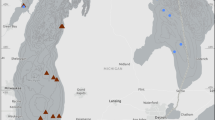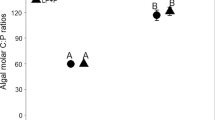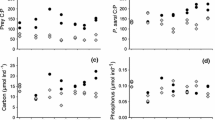Abstract
Stoichiometric theory predicts that organisms should experience dietary imbalances not only when nutrients (e.g., phosphorus, P) are limiting relative to carbon (C), but also when nutrients are in excess (i.e., well above somatic demand). Nevertheless, few experiments have elucidated the response of consumers in such low C:P conditions. We assessed the growth, tissue stoichiometry, and nutrient excretion of the invasive primary consumer, zebra mussel (ZM), Dreissena polymorpha, under three dietary C:P conditions (C:P = 20, 45, 380) in the laboratory. The two low C:P conditions represent increasingly common eutrophic systems, while the high C:P treatment is representative of oligotrophic systems. Growth rates and condition were lower when ZMs were fed a low C:P (20 and 45) diet, compared to the C:P = 380 treatment, wherein ZMs grew rapidly and exhibited lower somatic C:P. Furthermore, ZMs in the C:P = 20 and C:P = 45 treatments excreted more ammonia indicative of protein catabolism. These results clearly show that hypereutrophic conditions invoke significant shifts in physiology, growth, and condition of ZMs. Together, these results are consistent with stoichiometric theory that predicts costs associated with the intake of excess dietary P.




Similar content being viewed by others
References
APHA, 1995. Standard Methods for the Examinations of Water and Wastewater, 19th ed. American Public Health Association, Washington, DC.
Boersma, M. & J. J. Elser, 2006. Too much of a good thing: on stoichiometrically balanced diets and maximal growth. Ecology 87(5): 1325–1330.
Elser, J. J., D. R. Dobberfuhl, N. A. MacKay & J. H. Schampel, 1996. Organism size, life history, and N:P stoichiometry. Bioscience 46(9): 674–684.
Elser, J. J., W. F. Fagan, R. F. Denno, D. R. Dobberfuhl, A. Folarin, A. Huberty, S. Interlandi, S. S. Kilham, E. McCauley, K. L. Schulz, E. H. Siemann & R. W. Sterner, 2000. Nutritional constraints in terrestrial and freshwater food webs. Nature 408(6812): 578–580.
Elser, J. J., J. H. Schampel, M. Kyle, J. Watts, E. W. Carson, T. E. Dowling, C. Tang & P. D. Roopnarine, 2005. Response of grazing snails to phosphorus enrichment of modern stromatolitic microbial communities. Freshwater Biology 50(11): 1826–1835.
Frost, P. C., J. P. Benstead, W. F. Cross, H. Hillebrand, J. H. Larson, M. A. Xenopoulos & T. Yoshida, 2006. Threshold elemental ratios of carbon and phosphorus in aquatic consumers. Ecology Letters 9(7): 774–779.
Gonzalez, A. L., J. S. Kominoski, M. Danger, S. Ishida, N. Iwai & A. Rubach, 2010. Can ecological stoichiometry help explain patterns of biological invasions? (119, 779–790, 2010). Oikos 119(6):1056–1056.
Hawkins, H. J., H. Hettasch, J. Mesjasz-Przybylowicz, W. Przybylowicz & M. D. Cramer, 2008. Phosphorus toxicity in the Proteaceae: a problem in post-agricultural lands. Scientia Horticulturae 117(4): 357–365.
Hessen, D. O. & T. R. Anderson, 2008. Excess carbon in aquatic organisms and ecosystems: physiological, ecological, and evolutionary implications. Limnology and Oceanography 53(4): 1685–1696.
Higgins, S. N. & M. J. Vander Zanden, 2010. What a difference a species makes: a meta-analysis of dreissenid mussel impacts on freshwater ecosystems. Ecological Monographs 80(2): 179–196.
Hood, J. M. & R. W. Sterner, 2010. Diet mixing: do animals integrate growth or resources across temporal heterogeneity? American Naturalist 176(5): 651–663.
James, W. F., 2001. Phosphorus recycling by zebra mussels in relation to density and food resource availability. Hydrobiologia 455: 55–60.
Karasov, W. H. & C. Martinez del Rio, 2007. Physiological ecology: how animals process energy, nutrients, and toxins. Princeton University Press, Princeton.
Kilham, S. S., D. A. Kreeger, S. G. Lynn, C. E. Goulden & L. Herrera, 1998. COMBO: a defined freshwater culture medium for algae and zooplankton. Hydrobiologia 377: 147–159.
Kirsch, K. M. & A. R. Dzialowski, 2012. Effects of invasive zebra mussels on phytoplankton, turbidity, and dissolved nutrients in reservoirs. Hydrobiologia 686(1): 169–179.
Liess, A. & H. Hillebrand, 2005. Stoichiometric variation in C:N, C:P, and N:P ratios of littoral benthic invertebrates. Journal of the North American Benthological Society 24(2): 256–269.
Naddafi, R., K. Pettersson & P. Eklov, 2008. Effects of the zebra mussel, an exotic freshwater species, on seston stoichiometry. Limnology and Oceanography 53(5): 1973–1987.
Naddafi, R., P. Eklov & K. Pettersson, 2009. Stoichiometric constraints do not limit successful invaders: zebra mussels in Swedish lakes. Plos One 4(4). doi:10.1371/journal.pone.0005345.
Naddafi, R., T. Blenckner, P. Eklov & K. Pettersson, 2011. Physical and chemical properties determine zebra mussel invasion success in lakes. Hydrobiologia 669(1): 227–236.
Plath, K. & M. Boersma, 2001. Mineral limitation of zooplankton: stoichiometric constraints and optimal foraging. Ecology 82(5): 1260–1269.
Schindler, D. W., 2006. Recent advances in the understanding and management of eutrophication. Limnology and Oceanography 51(1): 356–363.
Silber, A., J. Ben-Jaacov, A. Ackerman, A. Bar-Tal, I. Levkovitch, T. Matsevitz-Yosef, D. Swartzberg, J. Riov & D. Granot, 2002. Interrelationship between phosphorus toxicity and sugar metabolism in Verticordia plumosa. Plant Soil 245(2): 249–260.
Smil, V., 2000. Phosphorus in the environment: natural flows and human interferences. Annual Review of Energy and the Environment 25: 53–88.
Smith, V. H. & D. W. Schindler, 2009. Eutrophication science: where do we go from here? Trends in Ecology & Evolution 24(4): 201–207.
Stanczykowska, A. & K. Lewandowski, 1993. Effect of filtering activity of Dreissena-polymorpha (Pall) on the nutrient budget of the littoral of Lake Mikolajskie. Hydrobiologia 251(1–3): 73–79.
Sterner, R. W. & J. J. Elser, 2002. Ecological stoichiometry: the biology of elements from molecules to the biosphere. Princeton University Press, Princeton.
Sterner, R. W. & D. O. Hessen, 1994. Algal nutrient limitation and the nutrition of aquatic herbivores. Annual Review of Ecology and Systematics 25: 1–29.
Sterner, R. W., T. Andersen, J. J. Elser, D. O. Hessen, J. M. Hood, E. McCauley & J. Urabe, 2008. Scale-dependent carbon:nitrogen:phosphorus seston stoichiometry in marine and freshwaters. Limnology and Oceanography 53(3): 1169–1180.
Strayer, D. L., 2009. Twenty years of zebra mussels: lessons from the mollusk that made headlines. Frontiers in Ecology and the Environment 7(3): 135–141.
Walz, N., 1978. The energy balance of the freshwater mussel Dreissena polymorpha Pallas in laboratory experiments and in Lake Constance. I: pattern of activity, feeding and assimilation efficiency. Archiv in Hydrobiologia Supplement Band 55: 83–105.
Wetzel, R. G., 2001. Limnology: lake and river ecosystems. Academic Press, San Diego, CA.
Wilmer, P., 2005. Environmental physiology of animals, 2nd ed. Blackwell Publishing, Malden, MA.
Acknowledgments
J.R. Bidwell and J.B. Belden are acknowledged for their insight and constructive criticism on a previous version. We thank P.C Frost for help in determining ZM TER values and three reviewers that improved this manuscript. This project was funded in part by Waters Grant-in-Aid of Research Award to RLM, and NSF grant # 0924401 to PDJ.
Author information
Authors and Affiliations
Corresponding author
Additional information
Handling editor: John Havel
Rights and permissions
About this article
Cite this article
Morehouse, R.L., Dzialowski, A.R. & Jeyasingh, P.D. Impacts of excessive dietary phosphorus on zebra mussels. Hydrobiologia 707, 73–80 (2013). https://doi.org/10.1007/s10750-012-1407-3
Received:
Revised:
Accepted:
Published:
Issue Date:
DOI: https://doi.org/10.1007/s10750-012-1407-3




